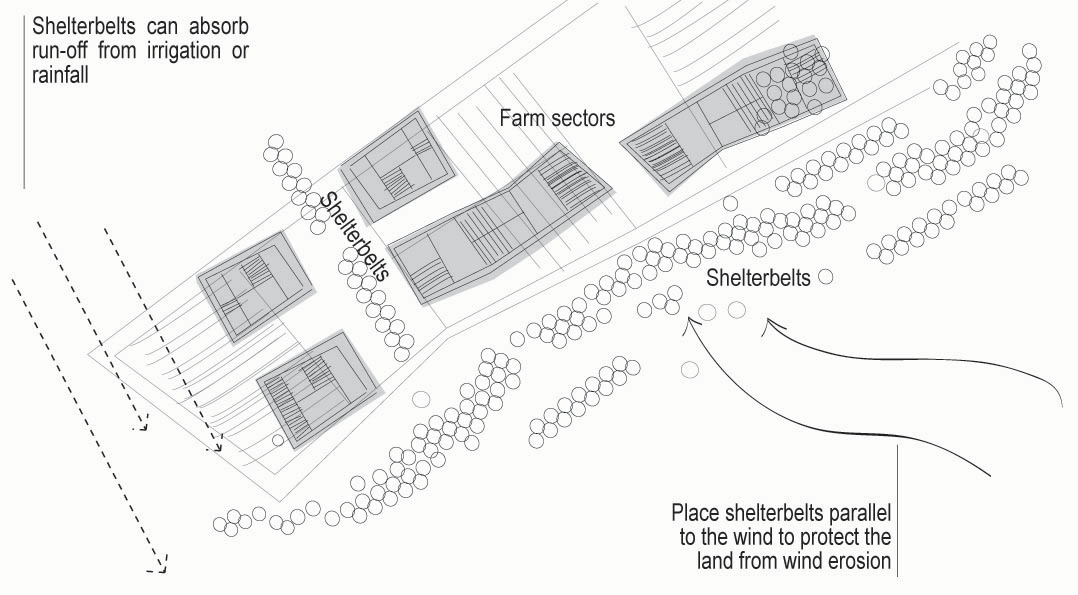
| goals | the garden | the farm | coastal reforestation | resources |

| The Farm |
Initial agroforest plantings contain seed-bearing plants that can wind disperse seeds upland, so planting in rows and allowing forests to infill naturally would be most effective.
There is also the potential to plant agroforests as shelterbelts to create vegetation forms, mimic debris lines, or emphasize topographical features.

The development of community-based agroforests as an alternative to less sustainable agricultural practices such as shifting cultivation which leads to the rapid destruction of forests. Establish agroforest shelterbelts alongside farmlands to supplement and replace agricultural activities, provide windbreak, and discourage the necessity of shifting cultivation. Field Shelterbelts reduce wind speed and prevent wind erosion, provide sheltered areas, and provide shade. |
|
|
|
How to Create a Shelterbelt |
|
| height and density | |
Dense shelterbelts that include tall standing trees of large, evenly dispersed canopies in order to effectively deflect and slow wind. |
|
| row design | |
| Plant 2-4 rows of taller tree species near the center of the shelterbelt to achieve an effective windbreak. Shelterbelts do not necessarily have to take up large portions of land, but biodiversity increases with the width of the shelterbelt. |
|
| species composition | |
Species selection determines the success of shelterbelts. It is important to choose native tree species of appropriate hardiness, foliage, uniform and dense canopy, and good live branch retention for the taller species that comprise the center (windbreak) of the shelterbelt. Smaller trees and shrub species should be planted on the outer edges of a belt in order to prevent shade-out from the canopy at the interior. |
|
| spacing between trees and/or shrubs | |
It is suggested that rows should be spaced al 2 to 4 meters apart to allow unrestricted growth. Low growing intercrops to be planted between rows to retain moisture |
|
| intercropping | |
Intercropping techniques can be implemented between tree rows to encourage agroforestry practices within a shelterbelt, simultaneously providing physical shelter and supplementing agriculture practices. |
|
|
|
Prototypical Phasing Plan |
|
Phase I [0-2 years] : Site Selection |
|
Select the location, form, and size of shelterbelt according to the demands, availability of the land, and how it will benefit the adjacent farming practices. Site shelterbelts close to farmland for ease of access. After plantings have been established on the farm, shelterbelts can be formed. Plant intercrops between rows of tree saplings. |
|
Phase II [2-7 years] : Intercropping |
|
Continued harvesting of intercrops. Once canopy has established, new intercrops and shade-tolerant tree and shrub species can be planted between existing rows of trees and replace herbaceous crop species. |
|
Phase III [8-19 years + beyond] : Integrating Agroforests + Farming |
Forest shelterbelt is fully matured and canopy can reach up to 35 meters in height. Agroforest practices and traditional farming activities are fully integrated. Shelterbelts are managed by adjacent farming communities, benefiting from additional crop resources while increasing the forested land and decreasing the necessity of shifting cultivation and slash and burn practices. |
|
Techniques Soil Short Term: At the farm scale, machines like a mechanical roller/tiller should be considered to mix coarse materials intothe soil to improve drainage (site and salt content specific). Long Term: Intercropped shelterbelts should be planted along windward periphery to slow runoff, check soil erosion and invasives, and to promote soil nutrients through intercropping and green mulching. When land is left fallow, controlled and productive species should be introduced to replenish soil nutrientsas well as substitute and discourage traditional slash-and burn practices. Water Short Term: The size and shape of the farm, the slope, and and the orientation of planting beds should all be considered to collect runoff and minimize surface evaporation (open water surface under tree canopy). On slopes, more drought tolerant species should be planted uphill, and more water demanding species like rice should be planted in depressions, valleys, or foothills. Long Term: Matching plant selection to site conditions reduces the need of long-term irrigation. Microtopography such as depressions or trenches helps to trap irrigation or drinking water. Maximize vegetation coverage to promote extensive and consistent infiltration rate and groundwater recharge.
|
|
| Planting List | |
| trees | |
| Ficus elastica (Rubber tree) | |
Elaeis guineensis Jacq. (Palm Oil Tree ) |
|
Pinus merkusii (Sumatran Pine ) |
|
Cocos nucifera (Coconut tree) |
|
| Acacia mangium (Akasia) | |
| intercrops | |
Sweet potato |
|
Cinnamon |
|
Leguminous crops- groundnut |
|
Rice |
|
| Maize | |
Soybean |
|
| Pineapple | |
| Banana | |
| Cocoa | |
| Taro |
| [Back to top] |